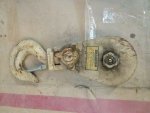So I called Skookum and asked them about the snatch blocks.
They said that they only made the 9/16 and 5/8 size snatch blocks for the army.
So, my interpretation is that either these trucks used a different brand snatch block for these trucks, or they were using a larger pulley than the cable size.
I asked if using a 1/2 cable in a 9/16 block was ok, and they said for this type of application, I could run it, but it is not ideally sized.
Does anyone know specifically which snatch block they issued for these trucks?
Sent from my iPhone using Tapatalk
Let me clear up some misinformation here. I don't know FMTV winches other than what's been posted here, but I collect block and tackle, civilian and military. I know blocks and rigging very well.
I'll start with Skookum, since they told you wrong. Skookum makes high end blocks, and some of my favorite blocks are Skookum, but whoever you talked to told you wrong. Skookum has made all different sizes of blocks for the military, from 1/4" all the way to 1-1/4". I've seen them in surplus lots. I had a military 7/8" Skookum block a couple years ago and I still have the military 3/4" block in the picture below. There is also Ulven which is the parent company of Skookum. Some Ulven blocks are double marked Ulven/Skookum and some are only marked Ulven. Regardless, Ulven and Skookum are the more common blocks the military used, with Skookum being the higher end blocks.

Sheave diameter is important but isn't the only critical factor. Groove size is just as important, if not more so. As stated above, there is a minimum diameter sheave that can be used with each diameter of wire rope. A larger diameter can be used without any issues. Larger diamter sheaves actually increase wire rope life but at some point huge sheaves become impractical. Sheaves that are too small cause the strands in the wire rope to bend too far causing premature fatigue of the strands.
Groove width on the other hand can cause damage if too wide and too narrow. If the groove is too narrow, the walls of the groove can be broken or the outer strands on the wire rope can be cut. If the wall is too wide then the wire rope is not supported. The wire rope flattens, causing fatigue from excessive internal friction between the strands. The wire rope is braided so strands cross each other. In an wire rope where the sides are not properly supported, these crossings become friction points and damage many strands all at once. This damage will mostly be internal and not apparent from a visual inspection. This is why most people say that flattening the rope "isn't that big of a problem". The damage just isn't apparent.
Something else to remember while looking for blocks is that there are lifting blocks and there are snatch blocks. There are also different braids of wire rope for both of those categories as well. Some blocks are sized specifically for the size, braid and use for their intended application. I say this because there is not a precise comparison that can be made for sheave diameter to groove size, or even the weight rating for that matter. Different safety factors, ratings and manufacturers further muddy the waters. An example in the picture below:


Both of the above blocks have 8" sheaves. The one on the left is a Warn 36,000# with a 3/4" groove for use with 1/2" wire rope. The one on the right is the one with the tag in the picture above, a Skookum 35 ton with a 1-1/4" groove for use with 3/4" wire rope. There is not a correlation between sheave size and groove width.
So to answer your question, you need a minimum of an 8" sheave with a ~3/4" groove. A larger diameter sheave is fine. The Warn block in the picture would suit your needs just fine. It's sized correctly and uses double ball bearings. They were issued with the BII for the MRAPs with the Warn 18k winches. They can be bought through surplus or on the civilian market. There are a couple companies making knockoffs of this style. The knockoffs all use brass bushings. The Warn is the only one using ball bearings. All my Warn blocks came through surplus.
If you want a stock block, the TM will have a BII list. Take the NSN and run it through Parttarget. You'll get a list of all the manufactures of that particular block and all the dimensional measurements you could want to help in your search.










